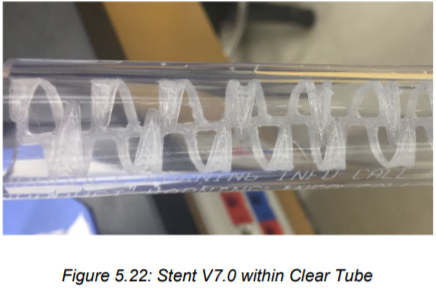Dynamically Fitting Unconstrained Nitinol Tracheal Stent
In the field of veterinary medicine, canine tracheal collapse is a relatively common issue and requires treatment to preserve respiratory function and quality of life in those afflicted. The tracheal stent is a device often used to reinforce the trachea and facilitate proper respiration. However, tracheal stents in use today suffer from significant design flaws that inhibit their ability to accurately fit patients, often leading to unwanted movement of the implanted stent within the trachea which can cause complications.
This canine tracheal stent design is optimized to best fit the shape of the canine trachea, minimizing movement of the stent within the trachea and reducing the risk of complications and migration of the device. This design is also easily deployable and adjustable, can fit a wide range of tracheal sizes, and leaves a large proportion of tracheal cilia exposed which avoids the buildup of mucous and foreign substances as a result of the device. Finally, the resilient nickel-titanium alloy of which the device is composed allows it to last.

Competing approaches & why we are better
In cases of canine tracheal collapse severe enough to necessitate medical intervention, two procedures are most commonly in use. The surgical placement of extraluminal rings to support the trachea does restore full respiratory function, but requires that an incision be made, and the surgery cannot be performed if the tracheal collapse extends into the thoracic cavity. Another commonly used procedure is the insertion of a tracheal stent to support the trachea internally. Tracheal stents in use today can be implanted without surgery in a minimally invasive endoscopic procedure, and can support the full length of the trachea if required. However, their current construction can allow them to move excessively within the trachea, increasing the risk of complications.
Similarly to tracheal stents currently in use today, this new tracheal stent can be fitted in a minimally invasive, non-surgical procedure, and can support the full length of the trachea as needed. However, this design also outperforms all existing stents at conforming to the tracheal walls, minimizing unwanted movement within the trachea and reducing the risk of complications. This design can also be fit to a wider range of tracheal dimensions and can be manufactured flat, meaning that it would have significantly lower production costs compared to existing devices.
Key Features/Benefits

This canine tracheal stent is designed to be inherently unconstrained, allowing it to expand dynamically to perfectly conform to the tracheal walls and fit many different diameters of trachea. The design of the device lends itself to minimal movement and migration as well as leaving tracheal cilia unobstructed to clear debris from the trachea which might otherwise cause infection or other complications. As a result of its intelligent design, fewer sizes of the device would need to be produced to fit a variety of patients, significantly reducing its cost of manufacture.